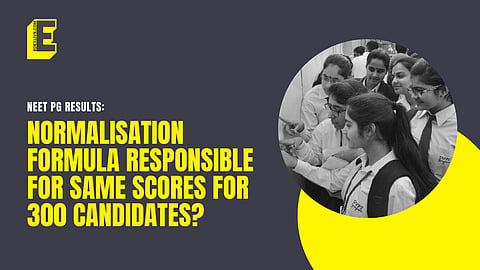

One of the most glaring discrepancies in the recently announced results of the National Eligibility-cum-Entrance Test for Postgraduate (NEET PG) admissions for 2024 is that over 300 candidates scored in the same percentile.
After the NEET PG results were announced on August 23, candidates took to social media, particularly X, to point out various inconsistencies and issues with their scores.
A few candidates alleged that they scored much less than what they calculated using unofficial answer keys issued by coaching institutes and demanded that the National Board of Examinations for Medical Sciences (NBEMS) release the official answer key of the exam.
A lot of candidates also claimed that several candidates scored the same percentile of marks in the exam, down to the exact decimal.
How is this possible? EdexLive spoke to medical exam experts to gain a better understanding of this development.
Improper normalisation formula
According to experts, candidates could only score the same percentile due to the formula used by the NBEMS in normalisation the scores in the two shifts.
“If the normalisation formula was implemented correctly, the percentile scores wouldn’t match for so many candidates. There would be differences in the decimal points,” says Gaurav Tyagi, Director of Career Xpert and NEET counsellor.
He adds that even a point-something difference in the scores could result in drastic differences in the rankings.
However, he states that the NBEMS did not clarify what normalisation formula it used in calculating the final scores of the two shifts.
“Before any formula is used for the normalisation of marks, it should receive approval from a court of law and a body of statistical experts. We do not know if the NBEMS has used a verified formula for normalising scores or not,” he explains.
To recall, the NEET PG was conducted in two shifts due to security issues, and the NBEMS announced that the scores would be determined for candidates in both shifts through a normalisation formula.
“If these discrepancies occurred because the NBEMS used an incorrect and unverified method for normalisation, then we have a huge blunder on our hands,” Tyagi says.
According to career counsellor and NEET expert Jayaprakash Gandhi, the lack of clarity on the normalisation formula is indicative of larger transparency issues in the NBEMS’ functioning.
“Why doesn’t the NBEMS openly declare what formula it is using to normalise the scores across the two shifts? How do we know if the appropriate formula was used?” he asks.
Normalisation of scores is a common practice used for competitive exams conducted in multiple shifts, Gandhi explains. He further says, “The NBEMS should have used the formula used to normalise Joint Entrance Exam (JEE) scores, as it has been tried and tested in the past. It would have made the process more transparent, to say the least.”
Such discrepancies and lack of transparency are indicative of the larger malpractices and incompetence in conducting medical exams in India, Gandhi alleges.
“We educationists have been asking the same question as aspirants — why medical entrance exams? We don’t see such controversies in other competitive examinations. It seems as if the medical examination bodies are not taking the gravity of medical education and exams into account,” he laments.
He adds that this apparent lack of seriousness towards medical education has left aspirants feeling stressed and helpless.
